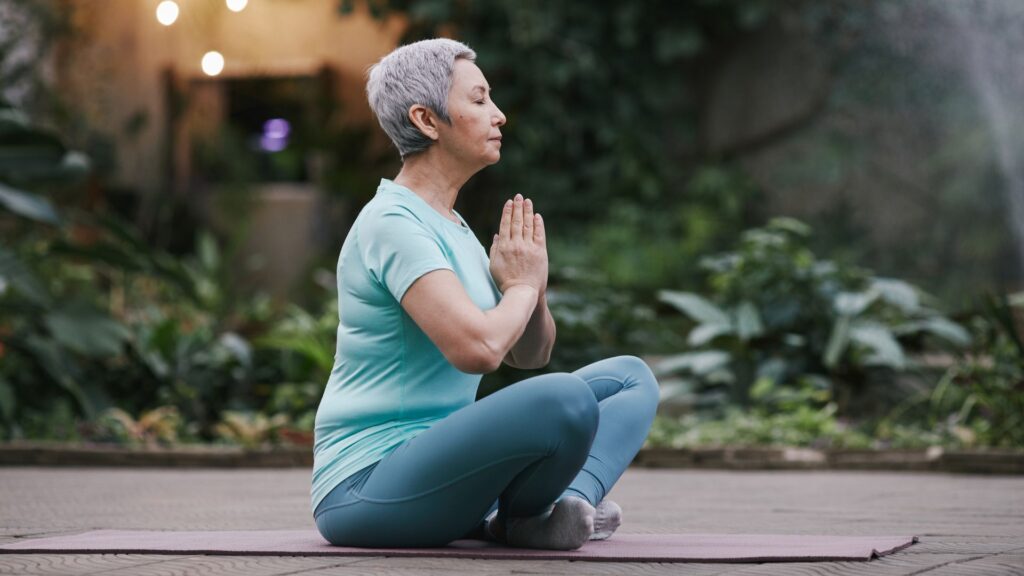“Yoga is a light, which once lit, will never dim. The better your practice, the brighter your flame.” —B.K.S. Iyengar, yoga master
Are you one of the 300 million people around the world who practice yoga, or one of the many people who have thought about trying yoga but have someone never gotten around to it—or are you one of the people who says “No, never, no yoga for me!”? Wherever you fall along the continuum, yoga truly has something for everyone.
Yoga is much more than the inspiring (or intimidating, depending on your perspective!) poses that you see in movies, commercials, and advertisements. At the heart of yoga is balance, and in a world that continues to swerve us this way and that, and turn our lives inside out and upside down from time to time, we could all use a boost in equanimity.
Benefits of Yoga
- Research indicates that yoga can help reduce biomarkers for inflammation in a variety of chronic conditions.
- Yoga nidra, which is a relaxing body scan meditation, has been found to reduce anxiety.
- Yoga promotes better posture and body awareness and may also support bone health and boost immunity.
- Practicing yoga improves strength, balance, and flexibility.
- A regular practice of yoga also boosts heart health and improves sleep.
- Additional benefits of yoga include improving your mood, reducing your stress, increasing your ability to relax, and reducing loneliness by connecting you to a supportive community.
While yoga certainly does help with our physical fitness, improving both strength and flexibility and gifting us with a whole host of additional benefits, the essence of yoga as described in the ancient yoga text of the Yoga Sutras by Patanjali, yoga is about reducing the waves of the mind.
Think for a moment about an ocean stirred up by a storm and how tumultuous the waves can become even to the point of becoming tidal waves capsizing large vessels. Our minds, similarly, can become very agitated, creating considerable stress and anxiety. The beauty of yoga is that it’s so multi-faceted that you can gain tremendous support for both your physical and mental health through yoga in a variety of different ways.
Seven Tips for Enhancing Mind-Body-Spirit Wellbeing with Yoga
The path of yoga overflows with opportunities for self-discovery and growth, and while the different facets of yoga’s prism considerably, their goal is the same: to bring the mind, body, and spirit back into harmony.
We offer the seven options below as inspiration for exploring yoga’s many facets as you start—or deepen—your yogic journey.
1. Exploring the Power of the Breath
Given that we’re breathing every minute of the day—even while we sleep—it’s super-easy to take breathing for granted. Taking time to learn some basic breath practices can bring radical transformation to both your physical and mental health. These benefits include improved sleep, reduced high blood pressure, and enhanced lung function. Yogic breathing practices can also soothe the mind and reduce stress. If you’re interested in sampling some of these breathing practices, the Innergy app has quite a few!
2. Anchoring Within
A central aspect of yoga is meditation. Increasingly, research shows that the benefits of meditation are far-reaching, including everything from lowering resting heart rate to lowering high blood pressure to improving sleep to reducing anxiety to lessening chronic pain and more. Begin by creating a quiet environment where you’re not likely to be interrupted, and choose a period of time when you can be still. Setting a timer can free you from wondering how much time has passed and let you enter into the experience more deeply. It’s often helpful to have some guidance and support when meditating, whether you’re just beginning or looking to take your practice to the next level. Tap into classes online, at meditation centers, at yoga studios, or on the Innergy app, and get ready to boost your health, happiness, and harmony.
“Yoga is the artwork of awareness on the canvas of body, mind, and soul.”—Amit Ray, author and teacher of yoga and meditation
3. Exploring Inward
Ready to dive deeper? The fifth limb of yoga involves withdrawing from sensory stimulation. Throughout the day, we’re typically actively engaging with the world—seeing, hearing, touching, tasting, and smelling. What percentage of your typical day is spent in quiet? “Pratyahara” is about withdrawing from this swirl of sensory input and becoming quiet as preparation for turning our attention inward. Becoming increasingly quiet is a powerful yogic path. Begin by simply turning down the volume on your devices. Then, go further by turning off some of your devices for periods of time. Devote a portion of your day to solitude. Start with a few minutes and build from there. Unplugging in this intentional way can be a transformational way to recharge and deepen your inner harmony.
4. Integrating Yoga into Your Day
A common misconception is that yoga is something that only takes place on a yoga mat. If you’re looking for a way to practice yoga that doesn’t involve breaking a sweat, take a look at the first two foundational limbs, or aspects, of yoga called yama and niyama, which are basically guidelines for living and include themes like non-violence, self-discipline, and contentment. Practicing even just one of these wholeheartedly can be more challenging than one of yoga’s advanced physical postures! For instance, to practice non-violence, you might not only refrain from criticizing others and complaining but also monitoring your internal chatter to see how kind—or unkind—you’re being with the thoughts you’re thinking about both yourself and others.
“True yoga is not about the shape of your body, but the shape of your life. Yoga is not to be performed; yoga is to be lived. Yoga doesn’t care about what you have been; yoga cares about the person you are becoming. Yoga is designed for a vast and profound purpose, and for it to be truly called yoga, its essence must be embodied.” —Aadil Palkhivala, yoga teacher and author
5. Observing with Compassion
It’s easy to get caught up in focusing on how a yoga pose looks—and how your yoga poses look—especially when you’re in a class setting. Bringing a contemplative mind to your yoga mat can deepen your practice. Try pausing between poses to bring awareness, considering how the pose you just did felt—in your physical body. Consider also what was taking place in your mind and in your emotions. For example, if you’re in Tree Pose, check to see if the level of equanimity of your mental body matches the balance of your physical posture. Just as it’s easy to lose your balance and start to wobble in Tree Pose—or any pose for that matter—it’s equally easy to lose your internal steadiness and veer into worry, doubt, sorrow, frustration, self-criticism, and distraction. Observing yourself—both on and off the mat—with compassion is a powerful way to deepen your practice. Start with being as kind to yourself as you are to others and go from there!
6. Journaling Your Yoga
Journaling is a wonderful way to deepen awareness by taking time to reflect on your perspectives and attitudes. There are various ways to bring journaling into your practice of yoga, such as journaling before you practice to take note of any intentions you may wish to set for how you approach your session or even a particular pose or breath. You can also keep a notebook by your mat to jot down impressions or observations after a pose. Journaling both before and after a session can give you the chance to compare any shifts that take place—in your body, mind, and/or your emotions. The relaxation you feel post-yoga can be a gateway to deeper reflection. Take time to consider what you experienced in your practice as a whole as well as what you felt in certain postures, while meditating, or while practicing certain breaths. Making a short list of what you’d like to focus on the next time you practice can bring inspiration and added motivation.
“Yoga is not a work-out, it’s a work-in—and this is the point of spiritual practice: to make us teachable: to open up our hearts and focus our awareness so that we can know what we already know and be who we already are.”—Rolf Gates, yoga teacher and author
7. Appreciating Your Yoga Journey
Yoga is not one pose or one practice but an ongoing daily journey that shifts and changes over time. At certain points in your life, for instance, you may be able to move into certain postures more easily than at other times. Practicing acceptance and gratitude is another way to deepen your yogic practices. For example, if you’re only able to reach your knees in a forward fold, it’s not helpful to criticize yourself for not being able to reach your toes. Embracing appreciation for your ability to touch your knees opens the door to receiving gratitude’s benefits, which range from reduced stress and anxiety to improved sleep and heart health. To deepen your experience even further, consider tapping into gratitude not just for your own practice but for all those who have been teaching and passing down the wisdom of yoga through the centuries!
“Yoga is the journey of the self, through the self, to the self.” —The Bhagavad Gita
In Conclusion
As you shape your yoga practice, keep in mind that it can be one, two, or more of the aspects of yoga, perhaps doing physical postures or meditation or breathing, or meditation along with breathing practices and journaling, or any other combination that feels good. It’s all up to you.
If you’re interested in yoga but not sure where to start, look for videos and classes online, as well as yoga sessions in the Innergy app. You can also find yoga classes in yoga studios, in parks, gyms, churches, ranging from beginner-level to advanced with a wide variety of styles, from chair yoga to restorative yoga to more vigorous styles.
Reading inspirational stories about yoga teachers through the centuries, watching yoga documentaries, attending a kirtan (a call-and-response musical style from India), participating in a veggie potluck, or going on a yoga retreat are also wonderful ways to tap into yoga’s healing nature.
Collectively, the community of yoga encompasses vast reaches of both time and space bringing together people all around the world, from those who practiced yoga long ago…to everyone who is practicing yoga today…to those who will practice yoga in forms not yet invented in generations to come. Truly, the timeless beacon of yoga has the power to rekindle the light of awareness within the heart and to bring abundant renewal of mind-body-spirit wellbeing to both young and old and everyone in between!






